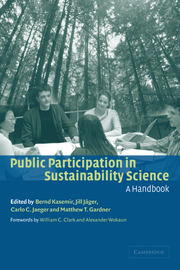Book contents
- Frontmatter
- Contents
- Notes on contributors
- Foreword: science, participation, and sustainability
- Foreword: sustainability, energy use, and public participation
- Preface
- Acknowledgments
- Part I Concepts and insights
- Part II Experiences with IA Focus Groups
- Part III Further forms of participation
- Part IV Future perspectives
- Introduction
- 11 From projects to program in integrated assessment research
- 12 Citizen participation and developing country agendas
- 13 Linking the citizen to governance for sustainable climate futures
- References
- Index
11 - From projects to program in integrated assessment research
Published online by Cambridge University Press: 22 September 2009
- Frontmatter
- Contents
- Notes on contributors
- Foreword: science, participation, and sustainability
- Foreword: sustainability, energy use, and public participation
- Preface
- Acknowledgments
- Part I Concepts and insights
- Part II Experiences with IA Focus Groups
- Part III Further forms of participation
- Part IV Future perspectives
- Introduction
- 11 From projects to program in integrated assessment research
- 12 Citizen participation and developing country agendas
- 13 Linking the citizen to governance for sustainable climate futures
- References
- Index
Summary
ULYSSES and Integrated Assessment
It is frequently argued that Integrated Assessment (IA) should be an international, multi-institute program, in which projects are covering for each other. In the current chapter, the research described in the first two parts of this volume is discussed from such a broad point of view. To that end, the authors explore if, and if so how, this research built upon previous IA projects and whether it provided input for subsequent IA projects. In doing so, its value for Integrated Assessment beyond the study's main products and insights is explored.
Apart from being a project that addressed the climatic change issue from the perspective of citizens, the ULYSSES project was explicitly designed as an Integrated Assessment (IA) project. For decades, scientists have been working with decision-makers to address local and regional problems in a more or less integrative manner, especially in the field of environmental policy, most of them without calling it “Integrated Assessment.” Although the term IA dates back to the 1980s, it is only since the late 1990s that IA has been recognized as a kind of profession and as a specific branch of scientific research. For that reason, it was not at all trivial that the project explicitly aimed to develop new IA methodologies.
When this study was designed, modelers, mainly natural scientists and economists, dominated IA. Modeling was considered as the way to do IA.
- Type
- Chapter
- Information
- Public Participation in Sustainability ScienceA Handbook, pp. 215 - 227Publisher: Cambridge University PressPrint publication year: 2003
- 1
- Cited by

